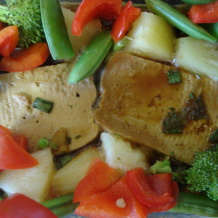Anti-Yeast Diets

With the rise in yeast infections and an epidemic of obesity on the horizon, wouldn’t it be great to find a diet that solves both problems? Well back in the day before the CDC downgraded yeast infections from public health danger to nuisance status there was a simple diet that did both. We don’t hear about it much today because government agencies are more focused on pandemics and e-coli in our food supply than yeast infections. However, back in the day when a Candida prevention diet was on the agenda, many prominent nutritionists worked to develop the anti-yeast diet and their findings are available for those who take the time to search for them.
What is the yeast infection diet?
The yeast diet, or more precisely, the yeast infection diet, thwarts yeast infections by eliminating the foods that are most desirable to Candida. In effect you feed your body but starve the yeast. In its weakened state yeast infection is easier to force out of your body with supplements or prescription medications. An added benefit of this yeast diet is improved metabolism and an immune system that functions as intended without artificial support. With improved metabolism and digestion, you will be able to absorb the natural nutrients in foods, and strengthen your immune system. Meanwhile you are eliminating any footholds yeast infections may have built in your body. So what is involved in this old diet with new value?
The yeast diet starts off with common foods known to cut off the elements in your body that keep yeast infections alive and well while they debilitate you. This diet substitutes the simple carbohydrates found in most comfort foods for the complex carbohydrates in fresh vegetables. Candida loves the simple carbs that quickly turn to sugar in the body, spike blood sugar levels and are stored as fat. Vegetables are complex carbs that also absorb fungal poisons (mycotoxins). They are part of the solution—not part of the problem. When you have a bowel movement these toxins get flushed down the toilet where they belong. Meanwhile, the complex carbs take longer to digest. Improved digestion allows your body to store the beneficial parts of food like proteins, vitamins and minerals. If your body has been under control of Candida fungi, your digestive system is impaired. So even if you took food supplements, they might not have done you much good because your digestive system did not know how to handle them. Instead it stored the nutrients that fed the Candida while you starved. Fresh vegetables help your digestive system restore order. Now you are fed and the Candida starves.
Finishing off the fungus
When the Candida begins to starve you may experience some flu-like symptoms. This is a good thing. Just as the body uses fever to kill unwanted germs, your immune system uses chemical defenses to prevent bad fungi from getting a foothold in your body. As the fungus dies, it may emit toxins into your body making you feel worse before you are able to purge the bad fungi completely. This will be short lived if you stick to the diet, but beware. Once your body stabilizes your digestive system and your immune system finally ejects the bad fungi, you will begin to lose weight. The only problem is that unlike diets that force you to reduce calories and leave you feeling as starved as the dying fungi, the yeast diet lets you eat as much of the complex carbohydrates as you wish. Chances are, without that starving feeling, you will seldom feel hungry enough to overeat or go back to refined foods, sugar, or trans fats. Your weight will begin to drop gradually and you will feel energetic enough to get more exercise. Exercise has been known to improve your disposition and keep you mentally healthy without prescription drugs. So thwart Candida and lose weight too. Try the Yeast Diet.

